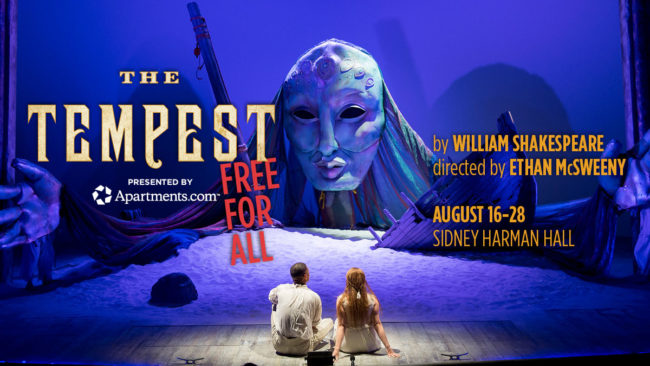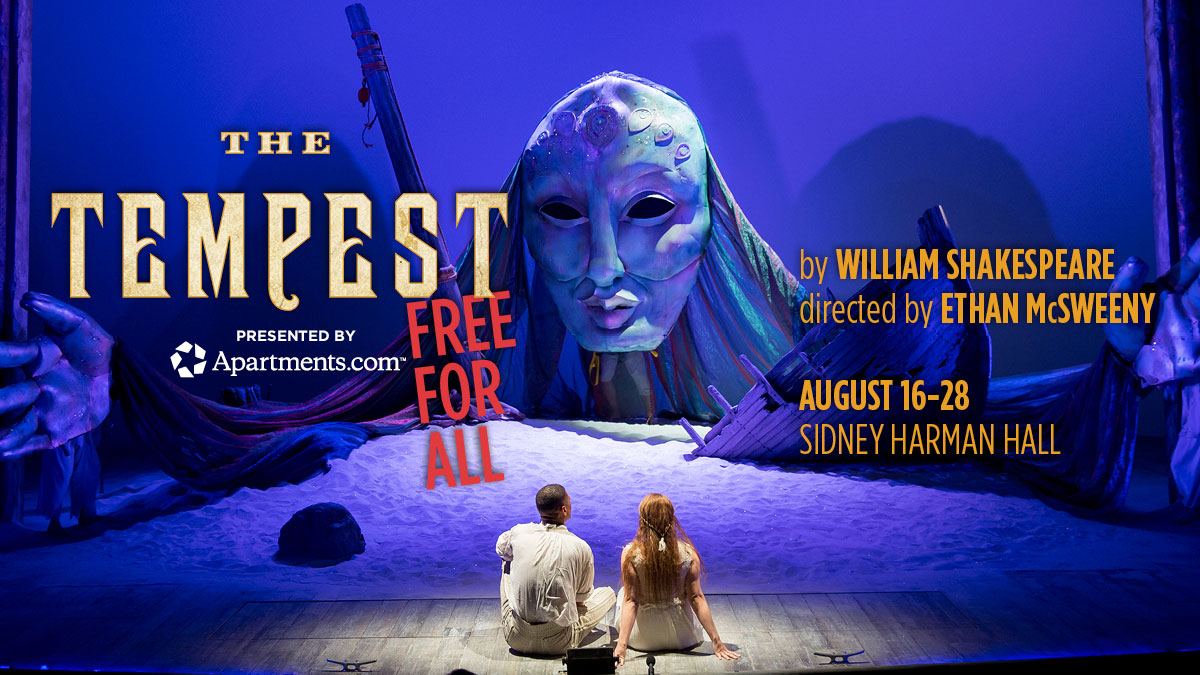With spirits to enforce and arts to enchant, Shakespeare Theatre Company offers up the most whimsically enchanting of the Bard’s theatrical canon with their production of The Tempest. Presented as the 26th Annual ‘Free for All’ performance, and Directed by Ethan McSweeny, Shakespeare’s final play is delivered with radiant justice, mesmerizing theatrical magic, and exquisite emotional endeavors that envelope the audience for a truly fantastical experience. The majesty of Lee Savage’s set juxtaposed against a myriad of miraculous production design elements make this a truly magnificent experience for all who are able to attend.

Scenic Designer Lee Savage takes the Bard’s stormy story and settles it down in a realm of pure fantasy. Mythically proportioned and looking like a step out of the lost Grecian Isles, Savage’s set is a playground of wonder, a visual delight that ensnares the eye from the moment audiences enter Sidney Harman Hall. A living sandbox which displays the wreckage of Prospero’s ship with ancient ruins that arise the full height of the stage, flanking either side of the proscenium fully envelop theatergoers in the world of the play. In addition to this astonishing aesthetic, Savage manages to keep the scenic artistry minimal, which allows not only for flight of the imagination but for focus upon the tale itself as it unravels amid the foam of the metaphoric tempest written into the text.
Lighting Designer Jennifer Reiser and Sound Designer Nevin Steinberg, working with Composer Jenny Giering, enhance both the visual and aural wonder of the show as a whole with their strikingly accurate cues laced firmly into their design work. The storm effects alone earn Steinberg and Reiser the highest of praises when it comes to authenticity, so much so that the moments when the maelstrom first brews are decidedly frightening in their execution and existence. Giering’s compositions for the play are stirring, underscoring scenic changes as well as the enchanting movement interwoven by Nancy Anderson and Choreographer Matthew Gardiner. While Gardiner’s dance routines are only featured toward the show’s conclusions, Anderson’s movement of the spirits (played by ensemble of ten) is showcased throughout the performance and is quite profound in its execution. Moving about as if they were enchantment themselves, these spirits become the magic we witness— be it a command from Prospero or Ariel— and they entwine themselves so fully into the mechanics of the show’s movement that they become scenic entities built with breathtaking grace.
Augmenting the very fabric of the show’s aesthetic, in a literal as well as figurative sense, Costume Designer Jennifer Moeller crafts deceptively simplistic threads that adorn characters of all walks. Though the more elaborate and regal garments are befitted to The King of Naples and his company aboard their ship, Moeller’s work is most resplendent in the outfits selected for the spirits of the enchanted island. Whimsical in appearance and wild in their nature they cultivate the look of mystery and intrigue that well suits these denizens of air and sea. Moeller’s costume work is the perfect complement to Puppet Designer James Ortiz, whose enormous creations blend flawlessly into the show’s aesthetic, despite their overwhelming size. Visually jarring, these puppets inexplicably capture the attention of the audience, seducing them into a trance of serenity once they’ve appeared near the show’s end.
There is much to be said in praise of Ethan McSweeny’s direction. Be it the way he takes the story away from Prospero, transplanting it into each of the other principle characters’ minds so that the audience can focus on the tale as a whole or the swift pacing at which he guides the show through, McSweeny delivers an extraordinary production in this visionary approach to The Tempest. Each moments crashes onto the audience like a wave of emotionally charged excitement, even in the less riveting moments of the show. Each wave ebbs and flows through the characters with a visceral hum that tingles and vibrates its way from actor to actor; this remarkable energy carries the show through the constantly churning plot that Shakespeare has constructed and allows for the comedy to be enjoyed, the drama to be processed, and the experience to be absorbed thoroughly.
There are many glorious flavors of praise well deserved of the entire cast; everyone from Alonso (Edward Gero), who is noble if bereft by grief, to Antonio (Gregory Linington) and Sebastian (David Bishins) both mischievous, devious, and heavily laden with a quick biting sarcasm, to sweet Gonzalo (Ted van Griethuysen), who waxes gently of his own accord in the scenes shared among the aforementioned. This gathering of talented performers makes the duller moments of this show feel lively, almost sprightly, in their existence and keeps these scenes feeling refreshing and engaging, particularly when it comes to minor subplots that unwind during their happening.
A pair of twit-witted mooncalves were never so well matched as Liam Craig to his Trinculo and Dave Quay to his Stephano. Both play exceptionally well with one another and with themselves; both are physically engaging and push the bodily humors of their comedic shtick to the breaking point. With Craig initially channeling some sort of blasé Elvis infested energy and Quay mounting his character’s drunken state with rigorous aplomb, the comedic relief is never more than a quick breath away with these two knocking about on stage. Enter Caliban (Clifton Duncan) and the whole series of interactive shenanigans among them bursts into a flaming exercise in who can garner more laughs from the audience.
Duncan delivers a versatile island servant; he is ripe in the swiftness of his character’s mood shifts. One minute cursing and standing against Prospero, the next cowering in urgent fear, Duncan masterfully places these energy shifts in the center of his body, which radiates through his physicality with ease. The way he carries himself among the drunken Stefano and Trinculo is equally engaging and his overall spatial relationship to the sand and to other performers is captivating as it gives a strong sense of how the character relates to and embraces or rejects his surroundings.
The two love-struck ingénues who are smitten from their initial discovery of one another toe the fine line of young lovers without falling into the sentimental overplayed stereotype that so often accompanies Ferdinand (Avery Glymph) and Miranda (Rachel Mewbron.) Though their time spent together is initially cautious and tentative, the chemistry builds quickly between them, with Mewbron bringing her own unique approach to the slightly petulant and under-exposed character of Miranda. The difference in their approach and viewpoint of the world and other characters around them is striking but plays well into the burbling emotions that are exchanged between the pair.
As free of spirit as her character is in physical flight, Sara Topham takes to Ariel like a breeze to a sail on a day where the winds favor the sailor. A curious amalgamation of iconic characters— a pixie-ish look of Tinkerbell, a spirited personality of Peter Pan and cheeky tongue of Puck— Topham’s Ariel soars above the rest of the performance— both literally and metaphorically— in an engaging fashion that pulls the attention of theatergoers every time she swoops into the scene. There is a fickle fondness for Prospero (Patrick Page) that is most readily felt in the more subtle exchanges between the pair, particularly noteworthy when Ariel pleads for freedom. Alight with an energy that defies description, Topham’s Ariel can best be described as delightfully daunting and wondrous strange.
Patrick Page brings life anew to the role of Prospero. Under Ethan McSweeny’s refocusing of the plot as a whole, Page relinquishes the harness of the story’s burden, distributing its weight evenly among the other characters but never falters in his command of presence or potency upon the stage. His ability to tell Prospero’s tale is remarkably clear, drawing the audience into every word as he speaks it. How beauteous his portrayal of the scorned Duke becomes, each passing scene unearthing a layer of compassion and complex emotion. There’s even a cheeky side that knows exacting comic timing— as witnessed in the line “no tongue, all eyes” delivered at precisely the right moment— making the versatility of his portrayal that much more impressive.
Shakespeare Theatre Company’s project, which is to please, has not failed, and it can only be hoped that you find yourself a seat in this mesmerizing and titillating theatrical experience before it washes away at summer’s end.
Running Time: Approximately 2 hours and 20 minutes with one intermission
The Tempest plays through August 28, 2016 at Shakespeare Theatre Company’s Sidney Harman Hall— 610 F Street NW in Washington, DC. 200+ tickets are available each day two hours prior to that evening’s performance curtain time, the line forms out in front of Sidney Harman Hall so arrive early! You can also entire the online ticket lottery by clicking here.

